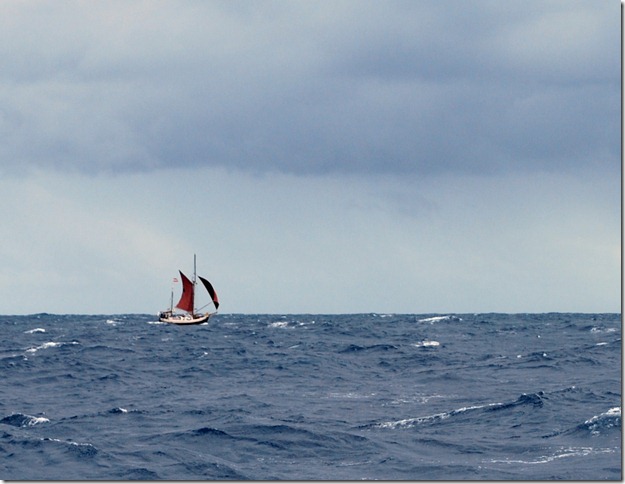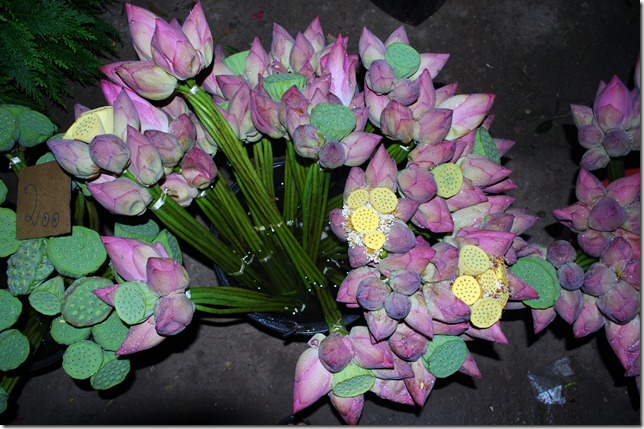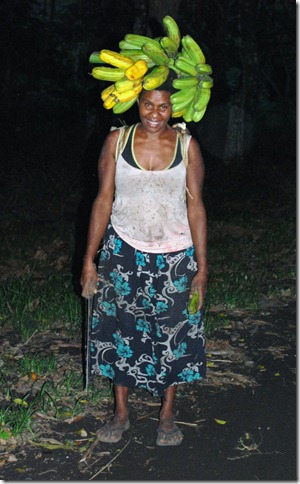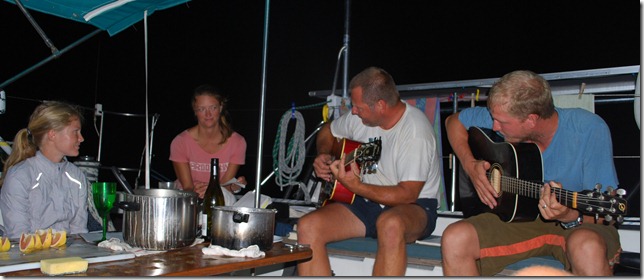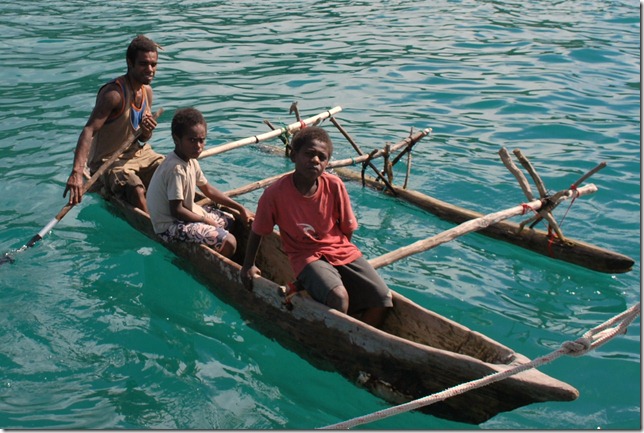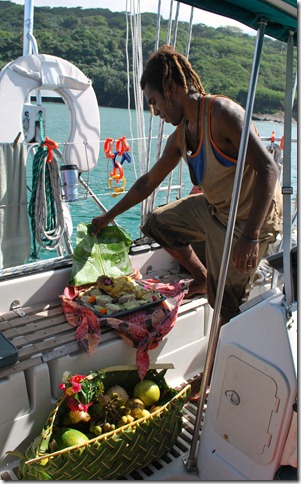The day after we slowly made our way to the top of the awesome volcano on Tanna, we were all pretty exhausted, and Dallas and Shiroma were feverish, so we decided to stick around and do very little for a day before sailing on to Port Vila. Ash managed to have a few more interesting encounters that day with locals who were interested in trading for gasoline, money, etc. The locals had lots of bartering power since they knew where to get home-grown tobacco and coffee, both of which Ash was in desperate need of.
We got up early the next morning and weighed anchor just before Anima. Shiroma jumped on the VHF to start the trash-talking with Martin to get him in the mood for a race to Port Vila. I guess she did a good job as he weighed anchor very quickly with his manual windlass, and we were soon on the same course passing by the continually smoking volcano. Anima’s two smaller sails outmatched our one jib in the strong but inconsistent following winds, and he arrived a few hours ahead.
Port Vila is the largest city in Vanuatu, and from the harbor it looks quite nice. The water is as clear as any city harbor water that I’ve ever seen (much better than Suva!), and there is lush vegetation all around. However, the main drag of town is catered to cruise ship passengers, so there’s a duty free shop on every corner, a few restaurants, bars, and resorts, and not much in the way of culture besides the colorful market.
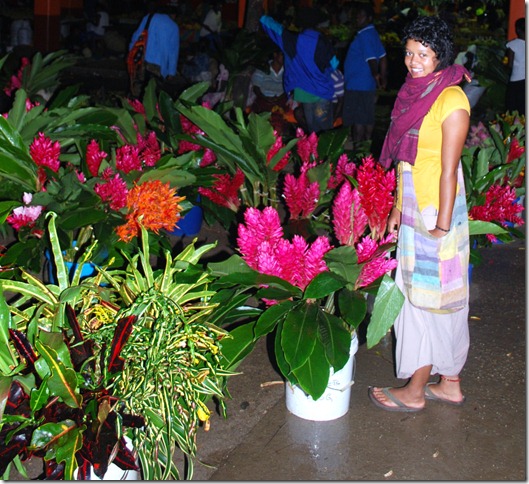 The tropical flowers are stunning
The tropical flowers are stunning
And sometimes surreal-looking
We ended up spending the weekend on a mooring just in front of the Waterfront Bar and Grill which turned out to be an especially convenient spot since it rained almost the whole time. Fortunately we had lots of people to socialize with. In particular I want to mention the German couple who are crewing on Anima because of their unique travel plans. They are just a bit older than us and after seven years of marriage, they took off on a "partner year" of travel that consists of destinations like here, the Great Wall of China, South Africa for the World Cup finals, Canada, etc. Their enthusiasm is contagious, and it’s worth taking a look at their pics even if you can’t understand German–"www.partnerjahr.de".
The nightlife in Vila consisted mostly of a couple of bars and dance clubs for tourists, but we briefly stopped in for a drink at one of the locals’ clubs on Saturday night. We got our fair share of attention since we were the only white people there, but I found the local men and women to be friendly and laid back. (Shiroma says the men were aggressive.) Almost everyone was dancing to the reggae music.
The Waterfront Bar turned out to be the place where cruisers congregated and waited out the rain, and it was there that we met the Kiwi delivery skipper for a 65′ superyacht called Anteus. Reese invited us over for some "nibbles" and to check out the boat on Sunday night, and we were all pretty impressed. It’s a racing yacht with a flat bottom and retractable keel that has been converted into a cruising yacht (sort of). With 400 square meters of sail, it planes across the surface of the water at speeds of up to 25 knots. It seemed to be an ideal boat for Reese who says has a new lease on life after a rugby accident that left him with a broken back and neck. His philosophy of "strong winds = hoist more sail" seems to be working out for him in the racing world as he just came 2nd in the solo Tasman race and is planning to participate in the Vendee Globe solo-round-the-world race next year.
Monday we checked out, provisioned with duty free supplies that can’t be opened until we leave Vanuatu (a big test of Ash’s will power!), and sailed out to Paul’s Rock just a few hours northwest of Vila. We arrived in time for some outstanding snorkeling before sunset. The fish here are fed by the local villagers on a regular basis, so they approach people when they get in the water! There were schools of fish of various kinds when we hopped in, and sure enough, when Colin swam past me, I could see a trail of fish swimming behind! The water was crystal clear, and the coral heads were blossoming with various shapes and colors.
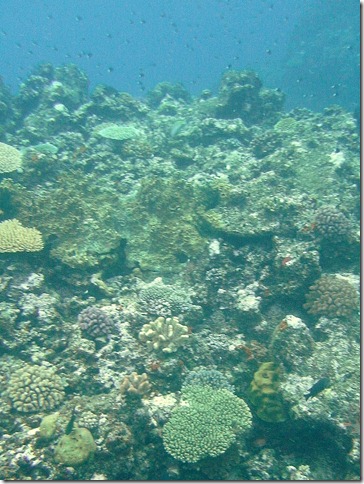 Plentiful coral at Paul’s Rock
Plentiful coral at Paul’s Rock
Shortly after we finished snorkelling, S/V Marionette arrived as planned, and we decided to finish the day with a fire on the beach. We headed to bed early after a weekend of late nights in the "city" (most of our crew got up at 1:00 a.m. the night before to watch Germany advance to the quarter finals of the World Cup) and slept extremely well with the rain pattering down on the boat.
Today we snorkeled some more and then dinghied over to a waterfall that Ash spotted from the boat, only to discover that we had landed our dinghy on the beach where Survivor: Vanuatu was filmed. We met a man from the nearby village who said he couldn’t take us to the waterfall without offering some money to the owner of the land (the chief of the neighboring village, I guess), but when he learned we just wanted to see the falls that we could see from the boat (just a little one caused by runoff from the rain), he agreed to take us in exchange for some tobacco. His English was really good, and he turned out to be an entertaining guide. We followed he and his dogs up through the mud to the landing where the water pooled and had a great time standing in the pool and letting the cool freshwater stream down over us. On the way back down the hill, Cathi and I spotted an interesting orange fruit growing in a tree. The guide used his knife to open it for us to reveal cocoa beans covered in a sweet white jellyish substance. Between this and the coconuts, crabs, fish, and wild pigs, the Survivor contestants were spoiled for choice of foods on this island!
Speaking of being spoiled, Shiroma is currently cooking another pizza, this time with garlic and a leafy green from the market that we are calling spinach. As much as I enjoyed French Polynesia, it was seriously lacking in reasonably priced quality food (esp. dairy products), and having them around definitely adds to the cruising experience. So does having Shiroma around!
Tomorrow the plan is to sail up to Cook’s Reef to do some scuba diving, followed by a night sail to Ambrym, called the "Black Island" due to the volcano ash and the use of black magic. There’s so much to see and do here in Vanuatu that we could easily spend a few months here, but we need to keep moving if we are going to make it to Indo by the end of August.
After a short stop back at the boat, Martin, Colin, Ash, and I jumped into the back of Dahwa’s truck again, this time with a local guide for the volcano, and headed off to gather more backside bruises and see the storied volcano. The Mt. Yasur volcano is the most accessible volcano in the world. Cruisers coming through Tanna 20 or 30 years ago had to make quite a long hike through the jungle, but there’s now a road, albeit a rough and washed-out one, that goes up to the edge of the cone a few hundred yards from the edge of the crater. Night was falling as we entered the gate at the base of the volcano and paid our $22.50 US per person to enter. The night became black while we were slowly grinding our way up the mountain and soon a light rain began to fall. We met another pickup coming down the one-lane track and after a bit of yelling and moving near the edge of the road, they finally squeezed by and we continued slowly upwards.
At the top, we met the others who had walked and made it to the summit around sunset. They were a bit tired and wet, but in good spirits. From the small area where trucks were parked, it was only a couple hundred yards up to the edge of the crater. There was a makeshift wooden railing to follow up, but rain had washed out the footpath and was actually easier to walk alongside. On the way up we could hear an eruption and see the sky glow orange with lava. The volcano had been silent until then and hearing it so close was a bit of a shock. Apparently Lauren screamed and was pondering a quick retreat the first time she heard it. To hear the earth make a sound like that and to then keep going toward is definitely against your instincts, but we were pretty excited to see the show.
The ground around the edge of the crater was gray volcanic ash strewn with lava bombs – rocks as small as stones up to 6 feet or so in diameter that had been thrown from the volcano and landed on the edge of the crater to cool. We hurried around and over them to the point that our guide recommended watching from given the current wind direction. He was pretty low-key, but did tell us to watch the highest piece of lava when we saw an eruption and if it was coming towards you, to start walking backwards while watching it. I looked behind us; about 25 feet away the edge of the crater gave way to a steep slope that ended hundreds of feet below – walking backwards wasn’t going to be the best idea. I can’t imagine people being allowed to stand at the edge of a volcano in the US, but here is was commonplace – no railing, not much in the way of safety signs, no guide certifications, and you’re free to spend the night on the crater’s edge if you want to.
We didn’t have to wait long. As we stood at the lip of the crater, hot, glowing magma shot into the air only a couple hundred yards away and as it did the volcano made a sound unlike anything I’ve ever heard. It’s a loud, alarming, explosive sound, but it’s also the sound of the explosion being vented as gasses and magma. It’s something like having a fighter jet engine very near by that’s turned on instantly, it’s also sort of like a combination of a next-door thunderbolt and a giant blowtorch. The magma streaked hundreds of feet in the air, from well below us to well above us. It seemed to fly in slow motion, and you could see the larger orange pieces slowly change shape as they spun and hurtled through the air. The magma pieces then dropped slowly to the ground onto a slope across from us, sometimes with a clattering sound, where they lay glowing while we waited for the next one.
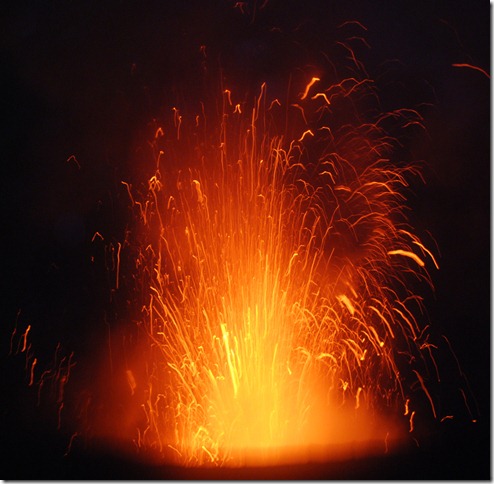 Yasur putting on a show
Yasur putting on a show
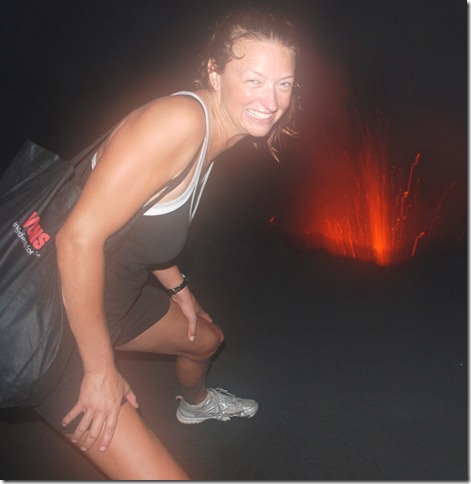 Front-row seat
Front-row seat
For at least 45 minutes we stood there mesmerized. Every time a particularly powerful eruption occurred we would yell at the rush of it all, fiery orange magma shooting through the sky, and the roaring of the volcano would drown us out.
The whole time there was an orange glow coming from just beyond the lip of the crater, where we were unable to see. Our guide said that if the wind had been from a different direction we could have stood on the other side of the crater and seen the magma glowing and bubbling like boiling water.
The others were waiting, so eventually we came down and 15 of us piled into the truck – 2 in the cab and 13 in the small truckbed. I was a little worried about the load on the truck for the ride back, but it didn’t complain a bit and Dahwa handled it expertly and slowly. In 45 minutes or so we were back in the village with the sounds of the volcano still ringing in our ears.
Our mission in Tanna was to visit the Mt. Yasur volcano. We’d first heard about it from Ken, the Rhodesian circumnavigator we’d met before even leaving the slip in Florida and it had been on our list of destinations ever since. First, however, we had to check into Vanuatu. Anchoring near the volcano in the protected bay at Port Resolution meant we’d have to take a truck across the island to Lenekal, the official port of entry and only real town on the island. We’d made inquiries about the truck the day before and were told that there were only two in the village and one would be ready for us in the morning. After morning visits from a couple of locals in outriggers to setup fruit trades, we dinghied in to shore.
Everyone was ready and waiting for us. Dawha was our driver. He’s 18 and been driving “professionally” for 3 years. His Dad Nelson and uncle Stanley were going to accompany Ash, Colin, and me to Lenekal and back. The ride was $20 round trip per person and would take two hours each way. The truck was a small red Mitsubishi diesel 4WD with a raised suspension and large, impressive tires. There was room for one passenger in the cab and the rest rode on a narrow wooden bench that circled the small bed of the truck. Almost immediately after leaving the village we realized that the raised suspension and large tires weren’t there to impress the other villagers. They were absolutely necessary if we were even going to get a few miles away from Port Resolution. There had been heavy rains recently and the “new road” had washed out, so we were taking the old road for the first few miles. Within minutes we were stuck when one of the rear tires dropped into a large rain-washed rut that was steep sided and more than two feet deep. After a bit of yelling and getting out to check our situation, Dahwa was able to drive us out without anybody getting off and we continued down the dirt track through the jungle that was often more wash-out than road. At especially narrow and dangerous spots, the locals had placed large sticks upright in the road to mark the edge of the navigable portion. We were white knuckled not out of fear or excessive speed (it was pretty slow going at first), but simply from the effort needed to balance on the narrow board or edge of the truck bed and to stay in the truck as it bounced and lurched along. We crossed over several makeshift bridges, including one that was made from two groups of three coconut tree trunks. Each group of three relatively closely-spaced trunks made a sort of lane for one set of tires to drive down lengthwise. It was clear that in heavy rains the other side of the island would be unreachable.
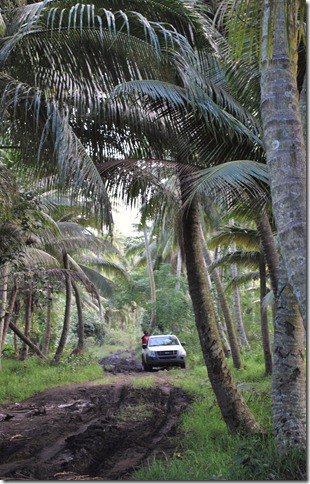 Local pickup navigating the “Tanna Highway”
Local pickup navigating the “Tanna Highway”
As we drove along, the condition of the road began to improve a little and we passed small traditional villages with thatched roof huts and people out gathering food. Much of the forest here it still untouched and it was truly amazing. Apparently the world’s 3rd largest banyan tree is here on Tanna, but the banyans we saw along the road were far larger than any we’d ever seen. Some had tree houses built in them that actually housed families, and we passed one small tourist resort that advertised banyan tree houses.
After an hour or so, we began to see the crater of the volcano above us, belching smoke, and before long we entered the volcano’s ash field. It was like a gray desert moonscape. The cleared road gave way to tracks over volcanic ash, and then the ash itself began to rain down on us like small particles of sand falling from the sky. The going was smooth now and the truck gained speed as we flowed over ash and stared up at the volcano’s crater. It was like a 1000-foot gray sand pyramid in the shape of a stingray’s back that would belch a slow mushroom of dark gray smoke every few minutes. We’d heard over the radio that Stanley was afraid of the volcano and didn’t make the best tour guide, and as soon as we entered the field area he pulled his shirt over his head to block the ash and had a rather unhappy look on his face. I asked him about the native beliefs regarding the volcano and he said that the volcano’s name, Yasur, and the name of their god were the same. They believed that the volcano’s rumblings and eruptions could be “read” for signs about the weather, harvests, etc. but that the people didn’t do anything to try to please the god/volcano. Apparently Yasur has a mind of his own. We were really awed the whole time we were in the ash field. Both there and on the way back there were a few other locals there walking around, though I’m not sure what they were doing. On the way back we noticed a soccer field setup at the edge of the ash field and locals kids busily engaged in a heated game of soccer while the volcano belched away beside them.
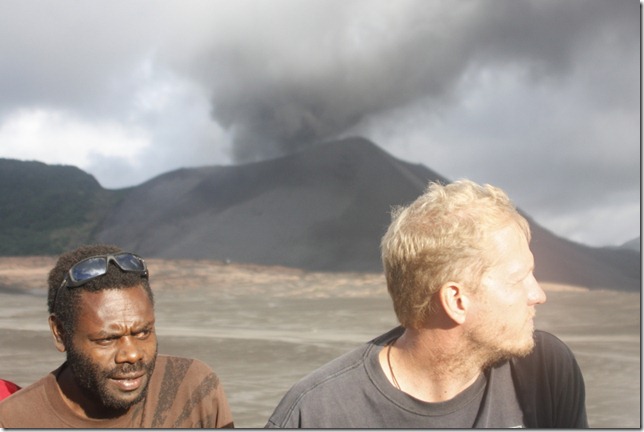 Nelson and I in the back of the truck as we’re crossing the ash field. Behind us smoke is rising from Mt. Yasur. (Photograph by Colin Murphey – http://www.deadreckoningreports.com)
Nelson and I in the back of the truck as we’re crossing the ash field. Behind us smoke is rising from Mt. Yasur. (Photograph by Colin Murphey – http://www.deadreckoningreports.com)
After leaving the ash field we began to climb and after seeing some picturesque views of Tanna from atop the mountains, we descended into Lenekal. Only at the outskirts of Lenekal did the road become as good as the typical dirt road in the US.
Throughout the town, we got a better taste of the local national language – Bislama. It is like a creole or pigeon English. If you read it aloud to yourself you can typically make it out, but the spelling is pretty comical if, like most people, you’re used to proper English where for whatever reason it’s not important to consistently spell words the way they sound. In the IsiBank (Easy Bank, the national bank), we read signs about what to do if you “wantem mane” to start a “smol bisnis”. Across the street from the bank was the Nambawan (sound it out) Coffee Cafe. We have a few photos, but it’s probably worth Googling Bislama signs or phrases or something like that to have a laugh.
After taking care of formalities (including having to chase down the quarantine officer), changing money (no way to get money from a card in Tanna), and eating lunch ($3 at a local restaurant) we were ready for the afternoon drive back. The drive back was much the same, except that when I sat back down on the hard, narrow wooden bench I realized that being woefully short of natural cushioning, I was already feeling a little bruised and the ride back would be a long one. We were joined by some more locals in the back of the truck, 8 or 9 of us all together. Young kids were out from school, but instead of sitting at home watching TV like in the US, they were generally out playing soccer barefoot or, machete in hand, walking out to gather fruit or vegetables for the evening meal. I couldn’t help but imagine what a US mother would think if her child showed up at home at 4pm barefoot, with a 2-foot machete, a big smile, a hand full of tropical fruit.
While passing one village, we drove through a festive procession of young children and adults where the young girls were dressed up in a native dress. They all yelled as we passed by and were clearly happy about something. Nelson told us that it was a coming of age procession and ceremony for the girls of the village. We stopped at a roadside veggie stand beside a giant banyan tree (at least 20 feet across) and the locals bought bundles of fresh peanuts and kava roots. I picked up some large pamplemousse. We haven’t seen them since French Polynesia and are enjoying them here. The fresh peanuts were pretty tasty; they’re totally different than the roasted ones we usually eat and taste a lot more like firm, fresh peas from the garden. At the veggie stand, Dawha and Nelson worked to re-attach the Argentina flag on the truck’s antenna. Soccer and the World Cup are all the rage here and many people have the flag of their favorite team flying somewhere. The games are during the middle of the night, so lots of the cruisers and villagers have been missing sleep to see them. There’s one TV with a satellite connection in the Port Resolution village that airs the games live for people to watch.
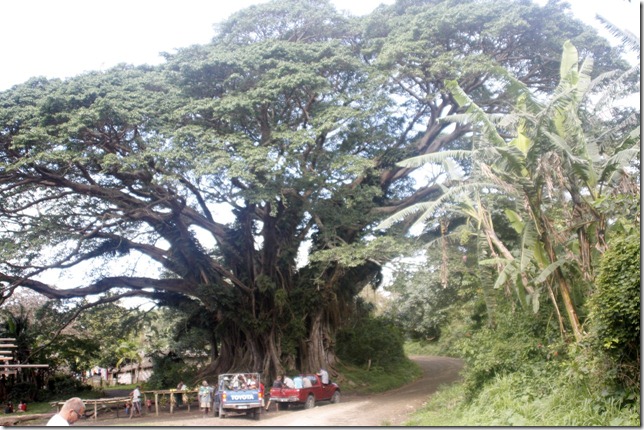 Roadside fruit & veggie stand under a wee banyan tree (Photograph by Colin Murphey – http://www.deadreckoningreports.com)
Roadside fruit & veggie stand under a wee banyan tree (Photograph by Colin Murphey – http://www.deadreckoningreports.com)
During our second trip through the ash field we raced another truck to the other side. Aside from a fixed spot to drive through the river that crosses the ash field, there isn’t any road per se, so Dahwa took a longer route at a higher speed to head off the other truck. In the back of the other truck was a white-haired grandmother who was sitting on a box chewing on a piece of fruit. She laughed and waved as we sped by and we had to laugh as well. Not too far past the ash field we passed Lauren, Shiroma, and a groups of other cruisers making the 3 hour walk up to the crater’s edge. We said hello, dropped off a couple of pamplemousse, answered the repeated questions about which one was my wife, then headed back to the boat to get ready for the ride up to the volcano to meet them.
Of all the places we’ve visited, Vanuatu is the one where there are more people living a lifestyle closer to pre-Western contact than any other. It’s more "National Geographic", traditional, primitive, or custom-life, and one of the important parts of that life here on Tanna is kava. It’s just as ingrained in the lifestyle as it is in Fiji, but in a very different way. It’s the strongest kava in the world and not only are women not allowed to drink it, they’re not even allowed to watch the men drink it. It’s an honor to be included, but apparently it can be as simple as asking. That’s what Markus did when they arrived, so Colin and I joined him to the "kava place" soon after landing and checking out the "Yacht Club".
We made inquiries in the village and were pointed down a path with trees overhanging on each side. At the end of the path, well away from the village was an island-style privacy fence created by standing large coconut fronds upright and supporting them with a more traditional fence made of wood and bamboo. We slipped inside one of the entrances in the fence and entered the nakamal. We immediately felt a little self conscious. The compound was in the shape of a large oval, maybe 300 feet or so across, and it was very quiet. Nobody was talking, and everyone seemed to be looking us over. Scattered throughout the nakamal were several of the local huts made of wood, bamboo, and coconut leaves with thatched roofs. Several small fires burned here and there and men of all ages wandered about or sat, generally in the vicinity of others, but not talking. There were maybe 50 or so men all together, clearly a good portion of the adult males in the small village. The one recurring sound was men spitting, with the healthy spitting preceded by the sound you usually hear when someone has had a chest cold and it trying to gather a good chunk of phlegm to spit out. The cause of that would soon become clear.
Markus found John, the local with short dreadlocks that had told him about the nakamal near the entrance and John invited us to sit on logs beside him. He checked to see if we still wanted to drink kava, said something soft and barely intelligible about chewing and then carried on fairly silently with a couple of friends nearby. I got to sit closest to the small group of men we’d sat down with, and by observing and asking a few quiet questions of whoever was nearest to me, I was able to put together what was going on.
Although the men gather every day in the nakamal for kava, today was a special day. Four 12-year old boys had been circumcised today (the ceremony had begun two days before) and were currently resting in the hut across from us, so this was something of a special ceremony. The men chat and talk until they start drinking the kava, and then they’re quiet, each generally still and silent, although there is the occasional hand gesturing, walking about, and throwing pieces of wood at roosters that wander into the nakamal. After drinking kava, they’re free to take some of the food on the ground in the middle of the nakamal, which was a mixture of pork and tapioca cooked and wrapped in banana leaves. Smoking cigarettes was a common pastime as well, and not having any lighters or matches, the men would pick up small limbs of or chunks of charred wood from the small, smoldering fires and use them to light up.
In Fiji, kava roots are dried, pounded into a powder, and then placed in a cloth and dipped in water until the water is brown and ready to drink. Here the process is a bit different. The men bite the fresh kava roots and chew them for a while, absorbing the numbing juices and turning the kava into a grayish lump that looks a lot like tuna salad. They then spit the chewed root onto a couple of leaves about 6 inches across until they build up a pile of chewed kava about the size of a softball. The chewed and spit-out kava root is then taken over to one of the two or three spots in the nakamal where water is poured into large old plastic containers and the kava is wrapped in an old cloth and then dipped and wrung out over the container by two men, one on each end of the cloth. The brown liquid is then put into coconut shells and you drink your shell worth of kava in one go.
We were only a few minutes away from our first taste of the kava drink when we put it all together and realized that we’d be drinking kava made from the pile of spit-out kava at John’s feet. All you could do was chuckle silently. Except for the few seconds when I thinking about the pile of spit-out roots, the kava tasted pretty good and was fairly strong.
The second time around, though, I thought it would be just as well if we experienced some of the root chewing, so I asked if we could try it. John handed some over and we all took a bite. It was a lot like trying to take a bite off of a tree; the way the locals bite if off and fill their mouths like it’s an apple or something is pretty impressive. After chewing for a bit it became softer and after we’d had enough, we spit our contributions onto the leaves. I had some idea that maybe we could actually drink our own spit this time, but it wasn’t to be. Our chewing result in a clump the size of a thumb that was still whitish, while their chewing resulted clumps almost the size of tennis balls that were well-chewed and grey. John brought over coconut shells with water in them for us to rinse and now we all understood the hacking and spitting.
John said we could have our second round whenever we were ready, so since it was getting close to sunset, we went ahead and told him to mix it up. He was back in a few minutes and we drank it down. During our time in the nakamal, several men came over to say hello and shake our hands and a couple sat down beside me for a quiet chat. The next day several men we met mentioned seeing us in the nakamal and one told us that it’s one way they keep the old customs alive — gathering everyday to enjoy some kava and learn from the chief and older members of the village.
Since our last blog, we had a couple of our best days at sea so far. The trade winds filled in as predicted, so we put up the spinnaker and left it up for most of the remainder of the passage to Tanna. In the calm seas and steady winds, we were averaging 7 knots without feeling like we were moving. We had forgotten what it was like to sail in such ideal conditions, and we were all in very good spirits, even Ash, who was in a bit of withdrawal since we didn’t have enough juice to constantly run the stereo.
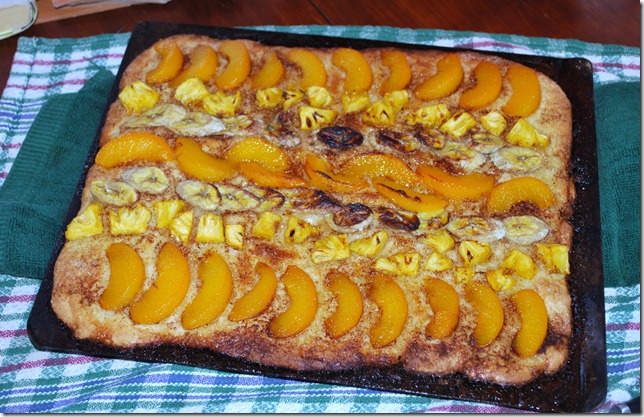 Shiroma even felt up for baking!
Shiroma even felt up for baking!
The speed of the boat must have been ideal for trolling as we caught four fish in two days! Considering we had never caught a fish before this passage, that is a pretty major accomplishment. Granted we threw two of them back (one was a medium-sized barracuda that Colin wasn’t sure about eating and the other was a tuna with parasites inside and out), but the two tunas that we kept were really good. We tried preparing them in several different ways–two kinds of sushi rolls, pan-seared, fried, and in tuna salad–and I liked them all. Dallas still hasn’t developed an affinity for fish, but for the rest of us, it is a great supplement to the usually vegetarian diet.
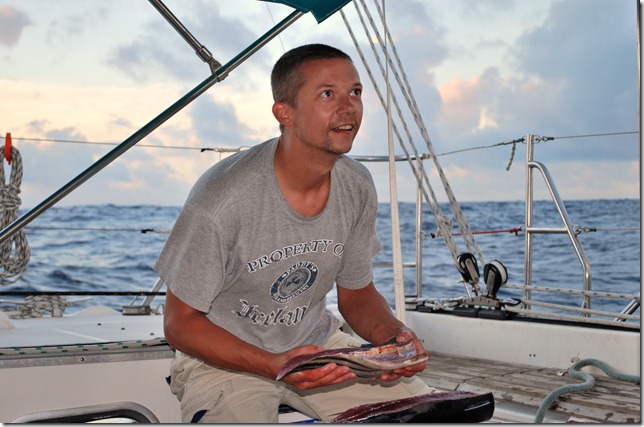 Colin was pleased with the catch of the day
Colin was pleased with the catch of the day
We cruised into the anchorage at Port Resolution on Monday afternoon and found that our friends on S/V Marionette had just arrived as well. (Those of you who have been following the blog for a while might recall that this was the boat that was declared missing during the September 2009 tsunami.) Ash and Colin were interested to discover that Cathi & Markus currently have three female crew (two Swedish, one German), and before long, Cathi and I were making plans for the five of them to join us for dinner aboard Pura Vida.
First we all went ashore to check out the “yacht club”, which turned out to be a large, empty, open-air room with a few folding tables. There was a sign advertising drinks for sale, but there were no drinks or staff to be found. We did, however, meet a local who had moved from the neighboring village into an isolated wooden bure next to the yacht club. He waited patiently while we caught up with our friends on his property before realizing that we should move on.
From there, Dallas, Colin, and Markus decided to head to the “Naka Mal” hut where men and only men are allowed to gather to drink kava. (Needless to say, this is at the top of my list of reasons not to live in Vanuatu.) It sounds like it was a really interesting experience, but I will let Dallas tell you about that…
The rest of us took a walk through the village before returning to the yacht club for a cold shower. (It was surprising to find indoor plumbing in a little shed outdoors.) The path to the village was beautiful, lined with the usual palms along with large banyon trees with sprawling roots that extend to the top of the trunks and beg to be climbed. We passed several people walking along, carrying wood or food back to their bures. Unlike Fijian homes, most of which were concrete shelters with an adjacent bure outside to serve as the hot weather shelter, this village contained only the thatched roof bures. The people we passed weren’t ebullient like those in Fiji and only looked and spoke to us when we spoke first.
Back on the boat, Shiroma and I prepared a nice meal for 10. Her potato pizza was so yum! While we had been ashore, S/V Anima had arrived to the anchorage, so the three aboard came over as well to bring our total guests to 13! Not bad for our first night in a new place! Martin brought his guitar, of course, and I did my best to recruit people to sing along. Most people just made requests, but one of Martin’s German crew was quite an enthusiastic participant.
The guys went to the other side of the island today to check in, get Vatu (local currency), etc. Shiroma and I stayed behind to hold down the fort and relax. We’ve already had a local come by in his outrigger along with his two younger brothers to bring over a basket of fresh tropical fruit (papaya, pamplemousse, passion fruit) and a plate of island-style chicken and taro, cooked up and ready to go. Apparently he made some kind of arrangement with Ash this morning…
The family transport
The fresh flowers in the fruit basket were a nice touch
We will meet up with the guys later on at the top of the volcano!! Shiroma and I are going to walk up with the Marionette crew (2 hours each way!), and the guys will arrive by truck when they get back from town. Looking forward to posting some pics of the crater when we get to Port Vila, probably in a few days.



